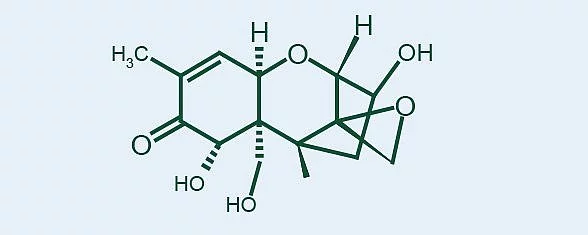What is Deoxynivalenol?

Deoxynivalenol is also known as vomitoxin or DON. It may co-exist with other toxins produced
by the same organism that produces this toxin, especially zearalenone.
Production and occurrence
Fusarium graminearum is the principal DON-producing fungus in grains but Fusarium culmorum is often involved as well especially in certain geographical areas of the world.
Corn and small grains such as wheat, oats and barley are the major crops affected. The organism survives on old infected residue left on the field from the previous season, providing an inoculum source for the new crop. The organism does well in cool, moist conditions with contamination of the crop occurring when spores (conidia) of the organism are windblown to the silks of the corn and in small grain to the anthers (male portions of the flower) which emerge outside the floret during what is called anthesis. The fungus penetrates the host ear or floret and produces the disease and DON. In wheat, it appears that DON production is necessary for the organism to produce the disease.
In corn the “ear rot” produced by F. graminearum may appear as purple to pink stained kernels with visible pink mold growth over the affected areas of the ear. Sometimes the growth of the fungus will appear through the husk as pink growth and staining and the entire ear will be affected. Wheat heads may appear prematurely ripe and the ripe kernels will have a blanched appearance (tombstone kernels) and may have pink stain present from the fungus.
This is not quite as evident in barley kernels, but oat kernels will have pink staining as well. The disease in wheat is called head blight, scab or pink scab.
Storage under good conditions (<14% moisture) will minimize further elaboration of the toxin by these toxigenic fungi. Conditions favorable to mold growth should be avoided as well as insect pests and moisture. Generally, storage is not considered a problem for DON contaminated wheat and corn that has matured and been stored at moisture percentages below 14%.
Toxicity
Swine are the animals most usually affected by this toxin and exhibit reduced intake of contaminated grain, if they do eat it, they may vomit. Levels above 1 ppm are considered potentially harmful to these animals. Pet foods prepared with wheat contaminated with this toxin have been involved in acute toxicities. DON is a known immunosuppressant and may cause kidney problems. Humans are thought to exhibit a similar vomition syndrome when consuming DON-contaminated grain. DON does not appear to carry over into tissues or fluids of animals consuming toxic levels. Baking and malting are adversely affected by contaminated wheat and barley.
Published on:
Mycotoxin